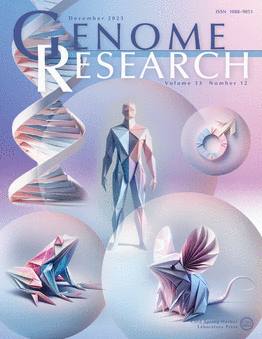ScisTree2可以通过高效的局部搜索实现细胞谱系树和基因型调用的大规模推断
IF 5.5
2区 生物学
Q1 BIOCHEMISTRY & MOLECULAR BIOLOGY
引用次数: 0
摘要
在多细胞生物中,细胞系有着共同的进化史。了解这段历史有助于研究发育、衰老和癌症。细胞谱系树代表了从生物体中取样的细胞的进化史。单细胞测序的最新进展极大地促进了细胞谱系树的推断。然而,单cell数据具有稀疏性和噪声性,且单cell数据的规模在快速增长。从大量单细胞数据中准确推断细胞谱系树在计算上具有挑战性。在本文中,我们提出了ScisTree2,一种基于无限位点模型的快速准确的细胞谱系树推断和基因型调用方法。ScisTree2依赖于一种高效的局部搜索方法来找到最优树。ScisTree2还根据推断的细胞谱系树调用单细胞基因型。在模拟和真实生物数据上的实验表明,与现有方法相比,ScisTree2的总体精度更高,效率也显著提高。据我们所知,ScisTree2是第一个基于模型的细胞谱系树推断和基因型调用方法,能够处理来自数万个或更多细胞的数据集。本文章由计算机程序翻译,如有差异,请以英文原文为准。
ScisTree2 enables large-scale inference of cell lineage trees and genotype calling using efficient local search
In a multicellular organism, cell lineages share a common evolutionary history. Knowing this history can facilitate the study of development, aging, and cancer. Cell lineage trees represent the evolutionary history of cells sampled from an organism. Recent developments in single-cell sequencing have greatly facilitated the inference of cell lineage trees. However, single-cell data are sparse and noisy, and the size of single-cell data is increasing rapidly. Accurate inference of cell lineage tree from large single-cell data is computationally challenging. In this paper, we present ScisTree2, a fast and accurate cell lineage tree inference and genotype calling approach based on the infinite-sites model. ScisTree2 relies on an efficient local search approach to find optimal trees. ScisTree2 also calls single-cell genotypes based on the inferred cell lineage tree. Experiments on simulated and real biological data show that ScisTree2 achieves better overall accuracy while being significantly more efficient than existing methods. To the best of our knowledge, ScisTree2 is the first model-based cell lineage tree inference and genotype calling approach that is capable of handling datasets from tens of thousands of cells or more.
求助全文
通过发布文献求助,成功后即可免费获取论文全文。
去求助
来源期刊

Genome research
生物-生化与分子生物学
CiteScore
12.40
自引率
1.40%
发文量
140
审稿时长
6 months
期刊介绍:
Launched in 1995, Genome Research is an international, continuously published, peer-reviewed journal that focuses on research that provides novel insights into the genome biology of all organisms, including advances in genomic medicine.
Among the topics considered by the journal are genome structure and function, comparative genomics, molecular evolution, genome-scale quantitative and population genetics, proteomics, epigenomics, and systems biology. The journal also features exciting gene discoveries and reports of cutting-edge computational biology and high-throughput methodologies.
New data in these areas are published as research papers, or methods and resource reports that provide novel information on technologies or tools that will be of interest to a broad readership. Complete data sets are presented electronically on the journal''s web site where appropriate. The journal also provides Reviews, Perspectives, and Insight/Outlook articles, which present commentary on the latest advances published both here and elsewhere, placing such progress in its broader biological context.
 求助内容:
求助内容: 应助结果提醒方式:
应助结果提醒方式:


